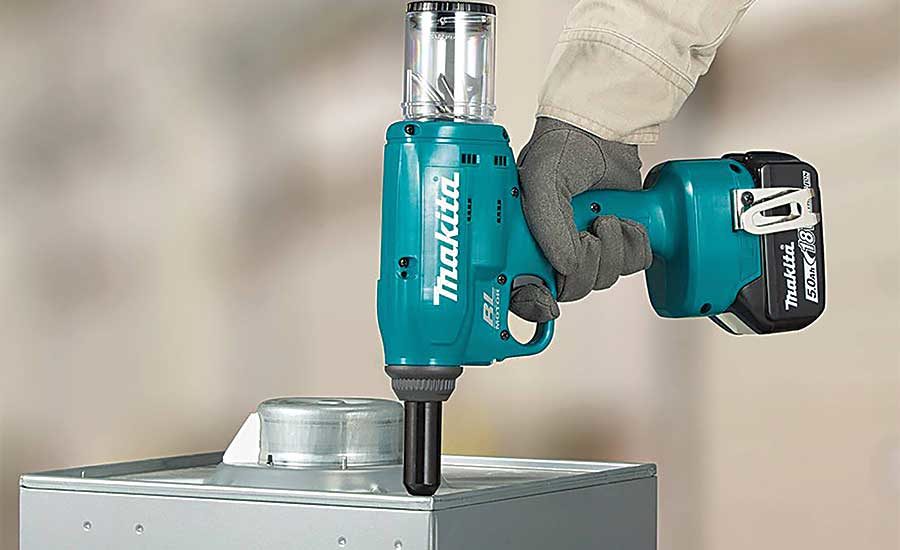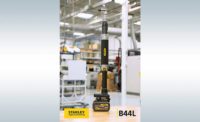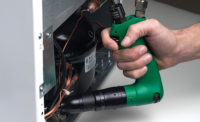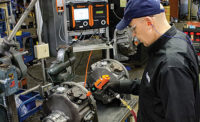Few technologies achieve widespread manufacturing acceptance in their original form. Most require some sort of modification before they begin to be regularly used on an assembly line. A good example is cordless power tools, which didn’t become commonplace in manufacturing plants until the mid-1990s, despite being first developed more than 35 years earlier.
In 1961, Black & Decker Corp. introduced the first cordless electric drill, powered by a nickel-cadmium battery. A few years later, the company contracted with Martin Marietta Corp. to design tools for NASA, including a zero-impact wrench for the Gemini project that turns bolts without spinning the astronaut. Black & Decker also designed a cordless rotary hammer drill for the Apollo 15 moon mission in 1971.
The first commercially viable cordless tool for end-users was Makita USA’s 6010D drill, a 7.2-volt tool designed for the general consumer market in 1978. According to Scott Christopher, national sales manager for assembly at Makita USA, extended success in the consumer market convinced Makita by the mid-1990s to specifically design precision-torque tools for assembly applications. This helped lead to the regular use of cordless tools in manufacturing beginning around the turn of the 21st century.
A few years ago, one major automotive manufacturer in the Southeast implemented a major expansion of its production line. The expansion included replacing more than 600 pneumatic and off-brand-battery tools with cordless Makita tools, resulting in significant benefits for the end-user.
“Operational tool costs have been reduced by an estimated 90 percent, due to lower energy consumption,” notes Christopher. “Plus, the tools precision torque capability has increased product quality. Other benefits include increased worker mobility, improved ergonomics, and the elimination of potential safety and trip hazards thanks to fewer air hoses. An added bonus is the company’s return on investment took only about six months.”
Cordless tools have grown exponentially in popularity over the past two decades. Proven benefits like mobility, accessibility and worker safety continue to attract manufacturers. Equally important, however, are technological advances that produce higher torque, greater accuracy and data-gathering capabilities for the Industry 4.0 plants of today and tomorrow.
A Big Bag
Manufacturers can choose from the widest variety of cordless tools yet, according to Christopher. Makita’s industrial cordless product offerings include screwdrivers, right-angle drills and ratchets, and a series of riveting tools launched earlier this year.
“Our biggest customers of cordless tools are building the biggest things,” notes Christopher. “These companies include those in aerospace, Tier 1 automotive, medical equipment, semi-trucks and buses, HVAC systems, solar panels, white goods and agriculture equipment.”
Christopher says that aerospace companies are increasingly using cordless tools because of the added mobility they provide to workers. Carrying a corded tool into, out of and all around a large plane all day long is not easy.
“Automotive assemblers regularly use our cordless tools to install dashboards, instrument panels and fascias for bumpers,” adds Christopher. “The automotive and other industries feel confident that their cordless tools can properly handle any project that involves threaded fasteners, and requires precise and high torque.”
Another appeal of cordless tools, according to Christopher, is not having to deal with cord-related dangers. The most obvious one is a worker tripping over the air hose. Less common, but no less dangerous, is when a worker leaves the tool in a vehicle that unexpectedly moves. The cord gets stretched too far, breaks away from the tool and risks hitting the vehicle driver or a nearby worker.
The Makita 14.4-volt DFL301RZ is a 3/8-inch square drive Torque Tracer angle nutrunner with a torque range of 16 to 30 newton-meters. It installs fasteners accurately and efficiently, with extended run time, and communicates fastening data wirelessly via Bluetooth.
Another key technology, available in many Makita tools, is USB programmabi-lity, which allows for multi-stage rpm control throughout the entire rundown. All of the company’s precision-torque tools have been user-certified for repeatability within 4 percent of mean torque. For accuracy, an ABS Voltage Sensor shuts the tool off when battery capacity drops below 5 percent.
AIMCO has supplied cordless tools since the late 1990s. Its current lineup ranges from screwdrivers, to impact and clutched tools, to continuous, discontinuous and transducerized models.
“Cordless tool usage is on the rise across all industries we serve, such as automotive, agriculture, heavy equipment and wind energy,” says Ken Maio, business development manager at AIMCO. “Wherever access is a challenge and the worker can’t easily move in there, cordless tools can help.”
Maio cites the example of a worker using a corded tool to build a vertical assembly. If the item has many fasteners on each side, the worker needs to walk around the object multiple times. As a result, he will wind the cord around himself and greatly restrict his mobility.
“The absence of a cord is a big deal in applications where cosmetics really matter,” says Maio. “One example is the truck sleeper cab. The manufacturer and customer definitely don’t want a tool hose to rub against the paint and create cosmetic damage to the vehicle.”
AIMCO recently introduced the cordless UBX-T70 pulse tool from Uryu Seisaku Ltd. Its design reduces the operating temperature of the hydraulic pulse oil, thereby helping assemblers produce at a high rate and lengthen service intervals by as much as 400 percent.
The tool features Auto Relief technology, which eliminates an initial torque spike during a cycle and delivers more pulses in less time for more efficient and even torque. This also provides virtually no torque reaction felt by an operator.
Cordless no-reaction mechanical pulse tools have been available from Panasonic Assembly Tools for more than a decade. The company also offers a transducerized nutrunner from HS Technique called the TorqBee.
Aziz Lokhandwala, product manager of assembly tools at Panasonic, says its AccuPulse series of pulse tools includes a model that produces as little as 2 newton-meters of torque. On the high end, the tools can reach 400 newton-meters of torque. According to Lokhandwala, the tools' high speed, repeatability and enhanced control make them effective in industries as diverse as automotive, white goods, construction equipment, aviation and furniture.
Enhanced control comes through two-way wireless communication between the tool and a nearby floor-mounted controller. Torque and other parameters can be preset or changed on the fly via the controller, which is also connected to the plant’s manufacturing execution system. Lokhandwala says the controller can monitor the tool’s performance on one or multiple fasteners. It can also be set up to simply indicate OK or not OK for each fastener.
“Modern cordless tools are lighter and more powerful than their predecessors—thanks mainly to advances in lithium-ion battery technology, such as greater power density and improved charging,” says Lokhandwala. “Equally important, cordless tools are only slightly more expensive upfront than corded tools, but provide freedom of movement and flexibility.”
Several decades after it started making corded power tools, Desoutter Industrial Tools came out with its first cordless model in 2005. The tool was a specialty drill designed for the aerospace industry and featured a nickel-cadmium battery, according to Russ Hughes, product marketing manager for cordless tools at Desoutter. In 2010, Desoutter introduced its cordless Delta hand wrench. The company has since added various clutch, direct-drive and reduced-reaction tools that use lithium-ion batteries to its product lineup.
“As battery technology has changed and improved, cordless tools have become more mainstream,” says Hughes. “Initially, cordless tools were used in limited ways, such as for specialized applications or test projects. Operators grew to like the tools, and this has also led to their acceptance.”
The heaviest users of the company’s tools are manufacturers in aerospace, agricultural equipment (including John Deere and Caterpillar), boats (Lund Manufacturing) and automotive. A little over two years ago, Magna Seating in Moore, SC, decided to get rid of all its corded tools to enhance worker mobility and ergonomics.
“We provided them with about 80 cordless direct-drive tools,” notes Hughes. “But, what they really like is that the tools can be controlled via wireless communication. In this case, it’s done using WiFi. Now the plant is able to operate seven days per week.”
Hughes says an often overlooked benefit of cordless tools is that they remove the need for a cable festooning system. This system helps safely guide electrical power to all of the tools in a plant. He does add, though, that batteries do require essential maintenance to optimize tool power.
The Desoutter EABS series of cordless right-angle nutrunners enable an assembler to tighten fasteners in cramped spaces with one hand, so he can use the free hand to support himself or hold other components out of the way. Each tool is ergonomically designed; weighs 2 pounds; is 11 inches long; tightens fasteners with up to 24 newton-meters of torque; and can run at speeds of up to 1,500 rpm. To further boost productivity, the nutrunner can be paired with the company’s wireless Connect smart hub for applications where traceability is essential. Pairing takes less than 10 seconds.
Since 2014, ESTIC America Inc. has offered cordless torque-tightening tools that feature direct-tightening and low reaction force electric-pulse modes. The company currently makes 12 types of such tools: four pistol-grip, four right-angle (direct drive only) and four right-angle (electric pulse only).
“Our cordless tool sales are definitely on the rise, especially for OEMs of commercial trucks, and agricultural and construction equipment, as using tethered tools in their plants can be prohibitive,” notes Dan Seay, North America general manager at ESTIC. “Automotive OEMs are also increasing their cordless tool usage in rework and repair stations.”
Several automotive assembly applications can benefit from cordless tools, according to Seay. One is tightening fasteners at the body-in-white stage. Cordless tools provide workers with more space clearance when tightening hard-to-reach joints such as roof fasteners and sensors. They also increase worker flexibility when assembling a range of joint types and installing vehicle-specific packages in different locations.
Last August, ESTIC added the EHC-T2100-AZ2 right-angle nutrunner to its T-Series cordless tool lineup. The tool’s proprietary pulse technology significantly reduces reaction force, thereby allowing operators to achieve tightening torques of up to 100 newton-meters without the need for torque arms or other reaction-force-assist devices.
Seay says the tool can be paired with the company’s EHC-IF20-Z2N controller unit, which can store up to 8,000 cycles of fastening data and lets workers use the cordless tool within a range of up to 30 meters. The tool is powered by a 36-volt battery and performs up to 1,000 fastening rundowns before a battery recharge is required. Torque-tightening accuracy is within ±7 percent.






